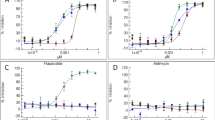Abstract
Pythium echinogynum, sp. nov. was isolated from soil samples taken from the vineyards of Tunisia, France and also from a lawn sown with turf grass in India. The oomycete is characterised by the presence of both ornamented and smooth walled oogonia. The ornamented oogonia are provided with blunt spines that can be at times curved, 1–2 monoclinous antheridia that can at times wrap around the oogonia, and mostly aplerotic oospores. The oomycete also produces elongated oogonia measuring up to 65 μm long and 24 μm in breadth. The internal transcribed spacer (ITS) region of the rRNA of this new species is comprised of 975 bp and closely resembles (95.9 %) that o P. spiculum and forms a clade together with members of the ornamented or spiny oogonia like P. mammilatum, P. spinosum and P. irregulare but also with those producing smooth-walled oogonia like P. paroecandrum, P. sylvaticum and P. cylindrosporum. However, it has its own characteristics, which are quite distinct from all other species of this genus described so far. In pathogenicty tests, the oomycete was found to be a severe “damping off pathogen” to tomato and cucumber seedlings. However these symptoms were not produced when the new species was grown together with P. lycopersicum—a newly described mycoparasite. The taxonomic description of this new species, its comparison with related oomycetes, the sequence of the ITS region of its rRNA gene, phylogenetic tree with related species and some account of its pathology to tomato and cucumber seedlings are discussed in this article.





Similar content being viewed by others
References
Belbahiri L, Gautier C, Esperanza SH, Tomasz O, Lefort F (2006) Pythium sterilum sp. nov. isolated from Poland, Spain, and France: its morphology and molecular phylogenetic position. FEMS Microbiol Lett 255(2):209–214
Cooke DEL, Drenth A, Duncan JM, Wagels G, Brasier CM (2000) A molecular phylogeny of Phytophthora and related oomycetes. Fungal Genet Biol 30:17–32
De Cock AW, LéVesque CA, Melero-vara JM, Serrano Y, Guirado ML, Gomez J (2008) Pythium solare sp. nov., a new pathogen of green beans in Spain. Mycol Res 112(9):1115–1121
Karaca G, Tepedelen G, Belghouthi A, Paul B (2008) A new mycoparasite, Pythium lycopersicum isolated in Isparta Turkey: morphology,molecular characteristics, and its antagonism with phytopathogenic fungi. FEMS Microbiol Lett 288(2):163–170
LéVesque CA, De Cock AW (2004) Molecular phylogeny and taxonomy of the genus Pythium. Mycol Res 108(12):1363–1383
Middleton JT (1943) The taxonomy, host range and geographic distribution of the genus Pythium. Mem Torrey Bot Club 20:1–171
Moralejo E, Clemente A, Descals E, Belbahiri L, Calmin G, Lefort F, Spies FJ, McLeod A (2008) Pythium recalcitrans sp. nov. revealed by multigene phylogenetic analysis. Mycologia 100(2):310–319
Paul B (1987) A new species of Pythium with ornamented oogonia from Algeria. Mycologia 79:979–802
Paul B (1992) Pythium radiosum, a new species from the Bank of Lake Zurich. Mycol Helv 5:1–8
Paul B (1999) Pythium ornacarpum: a new species of Pythium with ornamented oogonia isolated from soil in France. FEMS Microbiol Lett 180:337–344
Paul B (2006) Pythium apiculatum sp. nov. isolated from burgundian vineyards: morphology, taxonomy, ITS region of its rRNA, and comparison with related species. FEMS Microbiol Lett 263(2):194–199
Paul B, Bala K, Belbahri L, Gautier C, Sanchez-Hernandez E, Lefort F (2006) A new species of Pythium with ornamented oogonia: morphology, taxonomy, internal transcribed spacer region of its ribosomal RNA, and its comparison with related species. FEMS Microbiol Lett 254:317–323
Plaats-Niterink AJ (1981) Monograph of the genus Pythium. Stud Mycol Baarn 21:1–241
Waterhouse GM (1967) Key to Pythium pringsheim. Mycol Pap 109:1–9
White TJ, Burns T, Lee S, Taylor J (1990) In: Innis MA, Gelfand DH, Sinsky JJ, White TJ (eds) Amplification and direct sequencing of fungal ribosomal RNA genes for phylogenetics. PCR protocols: a guide to methods and applications. Academic, San Diego, pp 315–322
Author information
Authors and Affiliations
Corresponding author
Rights and permissions
About this article
Cite this article
Balghouthi, A., Jonathan, R., Gognies, S. et al. A new species, Pythium echinogynum, causing severe damping-off of tomato seedlings, isolated from Tunisia, France, and India: morphology, pathology, and biological control. Ann Microbiol 63, 253–258 (2013). https://doi.org/10.1007/s13213-012-0468-x
Received:
Accepted:
Published:
Issue Date:
DOI: https://doi.org/10.1007/s13213-012-0468-x




